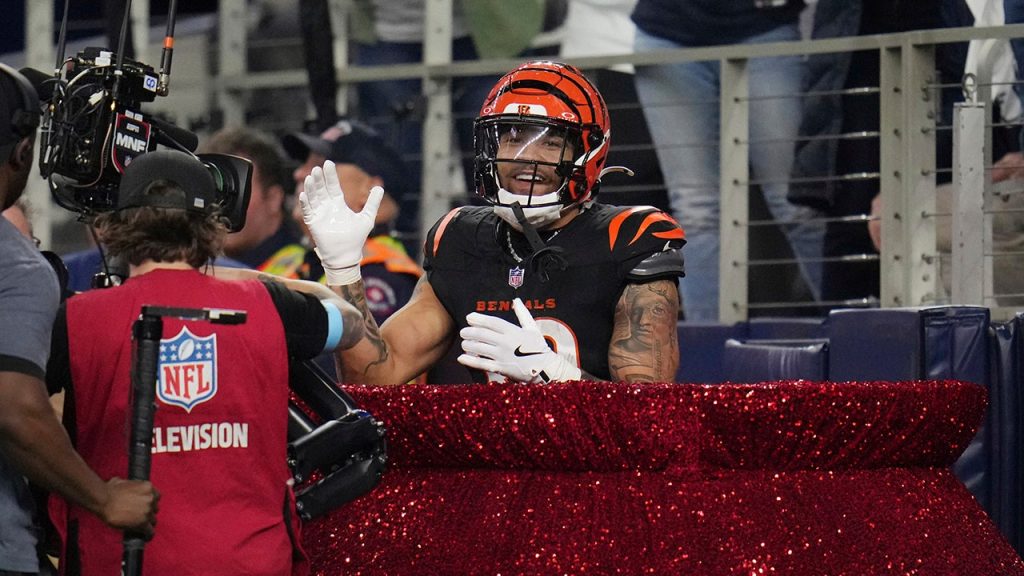Cincinnati Bengals running back Chase Brown experienced the bittersweet taste of NFL triumph and subsequent disciplinary action following a memorable touchdown celebration during a game against the Dallas Cowboys. His 19-yard touchdown reception from quarterback Joe Burrow, propelling the Bengals to a 14-10 lead in the second quarter, was punctuated by a leap into the iconic Salvation Army kettle, a fixture on NFL sidelines during the holiday season. While his celebratory act drew attention to the charitable organization, it also earned him a $5,000 fine from the league, a penalty he intends to appeal. Brown’s intention, he explained, is to reduce the fine and donate the remaining amount to The Salvation Army, viewing the strategically placed kettles as “bait” for celebratory impulses.
The incident highlights the conflicting nature of end-zone celebrations in the NFL – the desire for players to express their exuberance while adhering to league regulations. Brown’s leap into the kettle, while seemingly harmless and even beneficial to a worthy cause, fell afoul of the rules governing prop use in celebrations. This incident echoes a series of similar fines levied against Dallas Cowboys players in recent years, including Dak Prescott, Ezekiel Elliott, and several others, further underscoring the league’s stance on the matter. While the Salvation Army benefits from the increased visibility and potential donations generated by such celebrations, the NFL maintains its stance on maintaining decorum and discouraging the use of props, even for charitable purposes.
Chase Brown’s rookie season with the Cincinnati Bengals has been marked by impressive performance and solidifying his position as the team’s primary running back. Drafted in the fifth round of the 2023 NFL Draft, Brown quickly established himself as a key player in the Bengals’ offensive strategy. His statistics through 14 games showcase his versatility and contribution to the team’s success: 832 rushing yards and seven rushing touchdowns, complemented by 47 receptions for 318 yards and four receiving touchdowns. These figures demonstrate Brown’s ability to contribute both on the ground and through the air, making him a valuable asset to the Bengals’ offense.
The Salvation Army, a long-standing partner of the Dallas Cowboys, has collaborated with the team on various community initiatives for over three decades. The red kettles, symbolic of the organization’s holiday fundraising efforts, have become a ubiquitous presence during NFL games, serving as a visual reminder of the charitable spirit of the season. Ironically, these kettles have also become an irresistible target for celebratory displays by players, leading to a series of fines and highlighting the delicate balance between spontaneous celebration and adherence to league rules. While the NFL recognizes the charitable work of The Salvation Army, it maintains its policy against using props during celebrations, even for seemingly positive purposes.
Brown’s appeal of the fine reflects a desire to mitigate the financial penalty while simultaneously contributing to the charitable organization that inadvertently became part of his celebratory act. His suggestion to halve the fine and donate the remaining amount to The Salvation Army presents a potential compromise, acknowledging the league’s rules while also supporting the charitable cause. This situation underscores the complex intersection of player expression, league regulations, and charitable intentions in the context of professional sports. The outcome of Brown’s appeal will likely set a precedent for future similar incidents, shaping the way players and the league navigate these nuanced celebrations.
The incident involving Chase Brown and the Salvation Army kettle highlights the evolving landscape of end-zone celebrations in the NFL. While players seek creative ways to express their joy and excitement after scoring touchdowns, the league strives to maintain a balance between entertainment and appropriate conduct. The use of props, even those associated with charitable organizations, remains a point of contention, as the league aims to ensure player safety and prevent excessive or unsportsmanlike displays. The ongoing dialogue between players and the league regarding celebrations reflects the dynamic nature of professional sports, where tradition and innovation often intersect, creating moments of both excitement and controversy.

